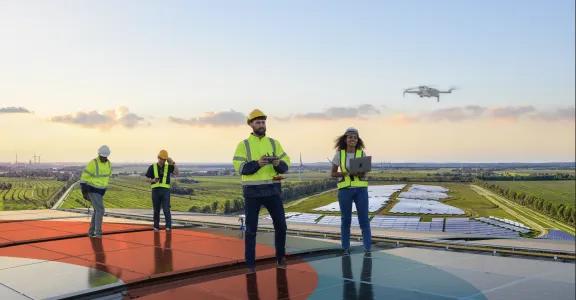Involving sales and production right from the design phase saves you time and money.
With the Make The Future programme, Agoria and Sirris guide businesses step by step towards Factory of the Future status. This intensive journey focuses on seven transformations that are essential for this development. An important component of this is the Integrated Engineering transformation. Pascal Pollet, an expert at Sirris, explains how this approach helps businesses save time and money by ensuring closer collaboration between design, production and sales.
Hi Pascal, what does the Integrated Engineering transformation involve?
Integrated Engineering ensures a seamless connection between the design/engineering and production of products. In the conventional approach, departments such as engineering, production and sales typically work in silos. You have engineers who develop and draw a design, which is then almost literally ‘lobbed over’ to production, where the operators are presented with something that’s not just hard to make but also quite expensive. Everything therefore goes back to engineering, who have to develop a new iteration, and so on. Ultimately, a lot of time is wasted in this way.
Integrated Engineering tackles this problem by bringing together all the parties involved right from the start of a project, to bring about a seamless connection between sales, production and engineering.
Why is this transformation so important?
The products that will be built tomorrow in the factories of the future are being developed and designed today. That means that we have to look at this phase if we want a factory to run smoothly tomorrow.
Integrated Engineering ensures that businesses can react to the market more quickly, which is crucial in a competitive environment. It shortens time-to-market, cuts costs and boosts quality. For manufacturers, a short time-to-market is essential, as products are most profitable at the start of their life cycle. And that’s exactly what Integrated Engineering ensures.
How do you put Integrated Engineering into practice?
Collaboration is key. Instead of separate departments, we set up cross-functional teams in which representatives from sales, engineering and production work together from the start. Typically, though, a team will be formed that includes representatives from the different silos from the start, with shared responsibility for the product’s success. Such success isn’t possible unless it both meets the customer’s specifications and can be marketed effectively. And that requires an acceptable time-to-market at acceptable costs and the right quality
It’s therefore important to form teams that are cross-functional so that they can work together from the start. Above all, you want to avoid too many iterations by means of this collaboration. The more problems you head off in the design phase, the less you have to go back to the drawing board: it’s easier to avoid obvious pitfalls in the concept phase than when you’re already making detailed drawings.
A good example is that some businesses give engineers a look-in as early as the quotation phase. That way, sales receives direct feedback on technical feasibility. This enables sales to make better proposals to customers, who often don’t know exactly what they need, let alone what is technically possible. You can deploy the expertise you have in this area further along the chain at an early stage. This allows you to come up with much faster and better quotations for your customers and means that you’re already working closely with them at an early stage. You then have an immediate advantage over competitors that they may also be talking to.
Another important aspect is knowledge-sharing. A design engineer who knows what parameters affect the manufacturability of a product, such as the wall thickness of an injection-moulded part, can forestall problems at an early stage of the design if he or she is involved. Finally, it’s a smart move to develop multiple concepts in parallel in the initial phase. If you then encounter a problem later on, you have an alternative to fall back on. It’s therefore best to compare multiple concepts side by side at the outset and take your time to evaluate which is the best.
A practical example: Picanol
At Picanol, a manufacturer of weaving looms, we saw how an Integrated approach can have an enormous impact. Originally, they worked with frames consisting of numerous components. Each component was made separately and assembled later. This was complex and time-consuming, so at a certain point Picanol opted for a radically different approach. They developed a frame that consisted of one piece. This initially made production more complicated, but the entire assembly process became far simpler and more efficient. The decision to do this was made possible through close collaboration between the engineering and production departments, which were based at the same site. This created a natural interaction and made rapid adjustments possible. This example shows how important it is to evaluate concepts critically right from the design phase, with a view to manufacturability and efficiency.
What are the advantages of Integrated Engineering?
The advantages are clear:
- Shorter time-to-market: With fewer iterations, the product is ready faster (‘first-time-right production’).
- Lower costs: A good design prevents expensive reworkings.
- Better quality: Collaboration from the outset leads to products that meet expectations right from the first production run.
Integrated Engineering seamlessly connects design, production and sales, allowing manufacturing companies to adjust their approach faster and cut costs while increasing product quality. Pascal Pollet, Principal Engineer Smart and Digital Factory at Sirris
What are the main challenges in Integrated Engineering?
Although the approach seems simple, many businesses still cling to old habits. This is often to do with the management and organisational culture, which likes to keep things divided into silos in order to retain an overview, but this is actually something from the past that we need to get rid of.
You want to go from sequential organisation, in which a product goes from the engineering phase to the process design and then the tooling is developed, to concurrent design, where everything runs in parallel and in consultation, so that all aspects are coordinated in close communication. The good news is that this isn’t rocket science, but it’s often a challenge to get small companies to take these steps. Major investments aren’t needed – it’s just a matter of bringing the right people together at the right time.
Read about the other transformations of the Make The Future programme:
Discover the Make the Future programme!
Want to know more about what Make the Future can do for your business? Find out here how this programme from Agoria and Sirris can help you transform your manufacturing company into a sustainable and innovative market leader.
For more information, contact our expert Pascal Pollet, or arrange a no-obligation appointment for an initial analysis of your business.




